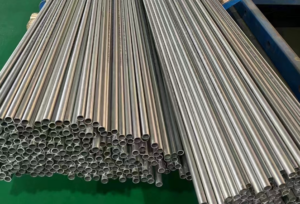Hastelloy C22 and Hastelloy C276 are both highly regarded nickel-based alloys that belong to the Hastelloy C series invented by the renowned Haynes International, Inc. These alloys are widely used in various industries due to their excellent corrosion resistance, mechanical properties, and weldability. However, despite their similarities, Hastelloy C22 and Hastelloy C276 differ significantly in their composition, density, and specific performance characteristics.

What is the difference between Hastelloy C22 and Hastelloy C276?
Firstly, the chemical composition of these alloys sets them apart. Hastelloy C22, with its composition of 00Cr22Ni60Mo13W3, boasts a high chromium content, which contributes to its superior resistance to oxidative environments. On the other hand, Hastelloy C276, with its composition of 00Cr15Ni60Mo16W4, exhibits a higher molybdenum and tungsten content, enhancing its corrosion resistance in reducing environments. These differences in composition lead to variations in the alloys’ physical and mechanical properties.
The density of Hastelloy C276 is slightly higher than that of Hastelloy C22 due to the higher molar masses of molybdenum and tungsten. This slight difference in density can be significant in certain applications, such as those where weight is a critical factor.
In terms of corrosion resistance, both alloys excel in various environments. Hastelloy C22 demonstrates exceptional resistance to pitting, crevice corrosion, and stress corrosion cracking. Its high chromium content enhances its resistance to oxidative environments, making it suitable for applications involving oxidizing acids. On the contrary, Hastelloy C276’s higher molybdenum and tungsten content improve its resistance to reducing acids and chloride-containing solutions. This makes C276 a preferred choice for applications in seawater or other chloride-rich environments.
When it comes to mechanical properties, Hastelloy C276 exhibits superior tensile and yield strengths compared to Hastelloy C22. The higher strengths of C276 are attributed to its alloying elements, which contribute to its overall structural integrity. However, it is worth noting that the selection of an alloy for a specific application should also consider factors such as temperature, pressure, and the specific corrosive environment.
Weldability is another crucial aspect where these alloys differ. Both Hastelloy C22 and Hastelloy C276 are known for their good welding characteristics. However, the specific welding parameters and post-weld heat treatment requirements may vary depending on the alloy and the desired properties of the welded joint. The high molybdenum content of Hastelloy C276, for instance, can affect the weldability and microstructure of the welded joint, necessitating careful consideration of welding procedures.
In addition to these fundamental differences, the alloys also exhibit variations in their response to heat treatment and cold working. Hastelloy C22, due to its high chromium content, may exhibit superior oxidation resistance at elevated temperatures. Conversely, Hastelloy C276’s high molybdenum and tungsten content may contribute to its enhanced resistance to hot corrosion and sulfidation. As for cold working, both alloys possess good cold forming properties, but the specific forming conditions and limitations may vary based on the alloy’s composition and microstructure.
Furthermore, the selection of these alloys for specific applications often depends on the compatibility of the alloy with the surrounding materials and the desired service life of the component. For instance, Hastelloy C22 may be preferred in applications where resistance to oxidative environments is paramount, while Hastelloy C276 may be more suitable in chloride-rich environments or where higher mechanical strengths are required.
Lastly, it is worth mentioning that the performance of these alloys can be further enhanced through the use of appropriate surface treatments or coatings. These treatments can provide an additional layer of protection against corrosion and wear, extending the service life of the components made from these alloys.
Conclusion
In conclusion, Hastelloy C22 and Hastelloy C276, while sharing many similarities, differ significantly in their composition, density, corrosion resistance, mechanical properties, and weldability. The selection of the appropriate alloy for a specific application requires a thorough understanding of the operating conditions, the desired performance characteristics, and the compatibility of the alloy with other materials.
Thank you for reading our article and we hope it can help you to have a better understanding of the difference between Hastelloy C22 and Hastelloy C276. If you are looking for Hastelloy C22 and Hastelloy C276 suppliers and manufacturers online now, we would advise you to visit Huaxiao Alloy.
As a leading supplier of Hastelloy Alloys from Shanghai China, Huaxiao Alloy offers customers high-quality Hastelloy products such as Hastelloy C22 and Hastelloy C276, Hastelloy C2000, and Hastelloy B2 at a very competitive price.



